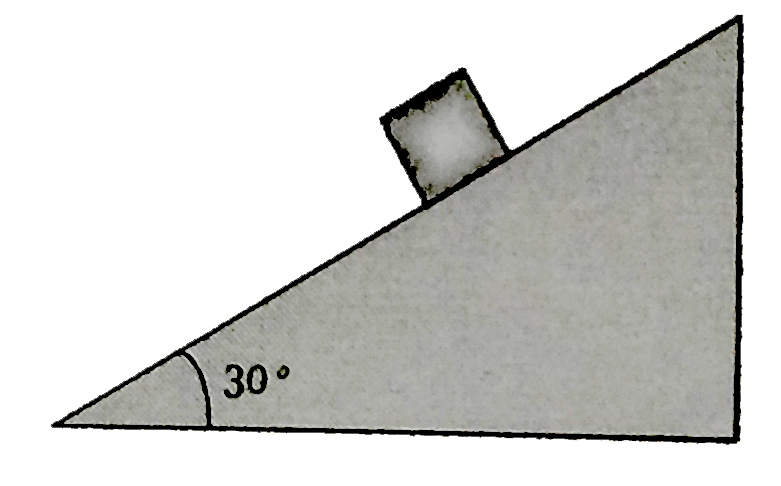A block of mass 5 kg and surface area 2m2 just begins to slide down an inclined plane when the angle on inclination is 30∘. Keeping mass same, the surface area of the block is doubled. The angle is which this starts sliding down is
30∘
60∘
15∘
none
The correct Answer is:A
To solve the problem, we need to analyze the forces acting on the block when it is on an inclined plane. The key point here is to understand how the angle of inclination affects the sliding of the block.
1. Identify the Forces Acting on the Block:
- The weight of the block (W) acts vertically downward and is given by W=mg, where m=5kg and g≈9.81m/s2.
- The normal force (N) acts perpendicular to the surface of the inclined plane.
- The frictional force (f) acts parallel to the surface of the inclined plane, opposing the motion of the block.
2. Calculate the Weight of the Block:
W=mg=5kg×9.81m/s2=49.05N
3. Resolve the Weight into Components:
- The component of the weight acting parallel to the inclined plane is W∥=mgsinθ.
- The component of the weight acting perpendicular to the inclined plane is W_{\perpendicular} = mg \cos \theta .
4. Determine the Normal Force:
- The normal force (N) is equal to the perpendicular component of the weight:
N=mgcosθ
5. Frictional Force:
- The frictional force can be expressed as f=μN=μmgcosθ, where μ is the coefficient of friction.
6. Condition for Sliding:
- The block begins to slide when the component of weight parallel to the incline equals the frictional force:
mgsinθ=μmgcosθ
7. Canceling the Mass (m):
- Since the mass (m) is the same on both sides, we can cancel it out:
gsinθ=μgcosθ
8. Simplifying the Equation:
- Dividing both sides by g (assuming g≠0):
sinθ=μcosθ
9. Dividing by cosθ:
- This gives us:
tanθ=μ
10. Conclusion:
- The angle at which the block begins to slide down the inclined plane depends only on the coefficient of friction μ and not on the surface area of the block. Since the coefficient of friction remains unchanged, the angle of inclination at which the block starts to slide will remain the same, which is 30∘.
Final Answer:
The angle at which the block starts sliding down the inclined plane remains 30∘.
- The weight of the block (W) acts vertically downward and is given by W=mg, where m=5kg and g≈9.81m/s2.
- The normal force (N) acts perpendicular to the surface of the inclined plane.
- The frictional force (f) acts parallel to the surface of the inclined plane, opposing the motion of the block.
W=mg=5kg×9.81m/s2=49.05N
- The component of the weight acting parallel to the inclined plane is W∥=mgsinθ.
- The component of the weight acting perpendicular to the inclined plane is W_{\perpendicular} = mg \cos \theta .
- The normal force (N) is equal to the perpendicular component of the weight:
N=mgcosθ
- The frictional force can be expressed as f=μN=μmgcosθ, where μ is the coefficient of friction.
- The block begins to slide when the component of weight parallel to the incline equals the frictional force:
mgsinθ=μmgcosθ
- Since the mass (m) is the same on both sides, we can cancel it out:
gsinθ=μgcosθ
- Dividing both sides by g (assuming g≠0):
sinθ=μcosθ
- This gives us:
tanθ=μ
- The angle at which the block begins to slide down the inclined plane depends only on the coefficient of friction μ and not on the surface area of the block. Since the coefficient of friction remains unchanged, the angle of inclination at which the block starts to slide will remain the same, which is 30∘.
The angle at which the block starts sliding down the inclined plane remains 30∘.
Topper's Solved these Questions
Similar Questions
Knowledge Check
- Question 1 - Select One
A block of mass m and surface area A just begins to slide down an inclined plane when the angle of inclination is π/5. Keeping the mass of the block same, if the surface area is doubled the inclination of the plane at which the block starts sliding will be .
Aπ/5Bπ/10Cπ/5Dπ/5√2 - Question 2 - Select One
A block of mass m and surface area A just begins to slide down an inclined plane when the angle of inclination is π/5. Keeping the mass of the block same, if the surface area is doubled, the inclination of the plane at which the block starts sliding will be
Aπ/5Bπ/10C2π/5Dπ/5√2 - Question 3 - Select One
A block of mass 10 kg is placed on an inclined plane when the angle of inclination is 30∘. The block just begins to slide down the plane. The force of static friction is
A10 kg wtB89 kg wC49 kg wtD5 kg wt
A brick of mass 2kg just begins to slide down on inclined plane at an angle of 45∘ with the horizontal. The force of friction will be
View SolutionA block of mas m begins to slide down on an inclined plane of inclination θ. The force of friction will be
View SolutionThe time taken by a block of wood (initially at rest) to slide down a smooth inclined plane 9.8 m long (angle of inclination is 30∘) is
 View Solution
View SolutionA block is about to slide down an inclined plane when its inclination to the horizontal is θ. If now a 5 kg weight is attached on the block :
View SolutionA mass of 1 kg is just able to slide down the slope of an inclined rough surface when the angle of inclination is 60∘ The minima force necessary to pull the mass up the inclined plane is: (g=10m/s2)
View Solution


